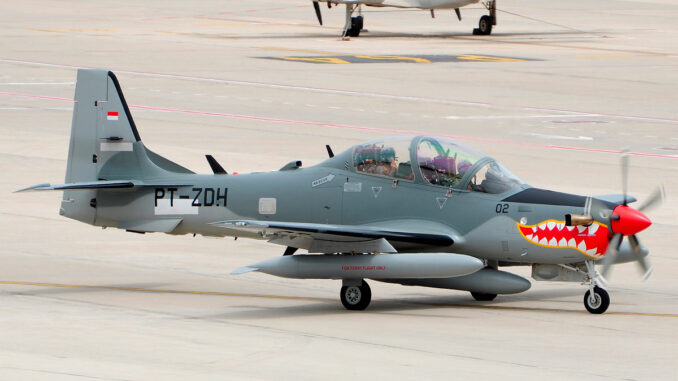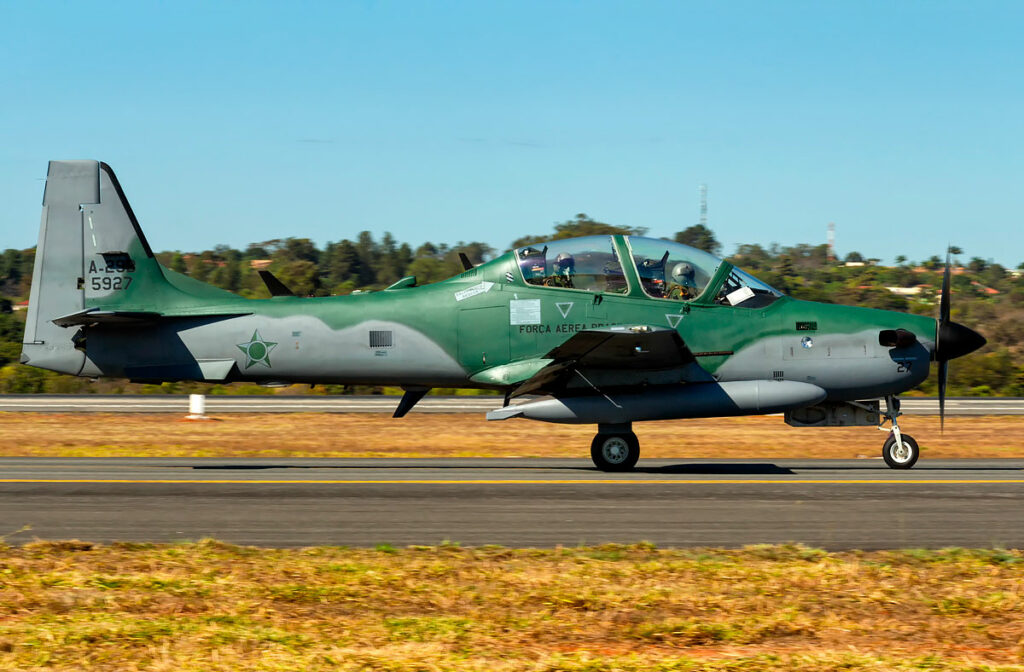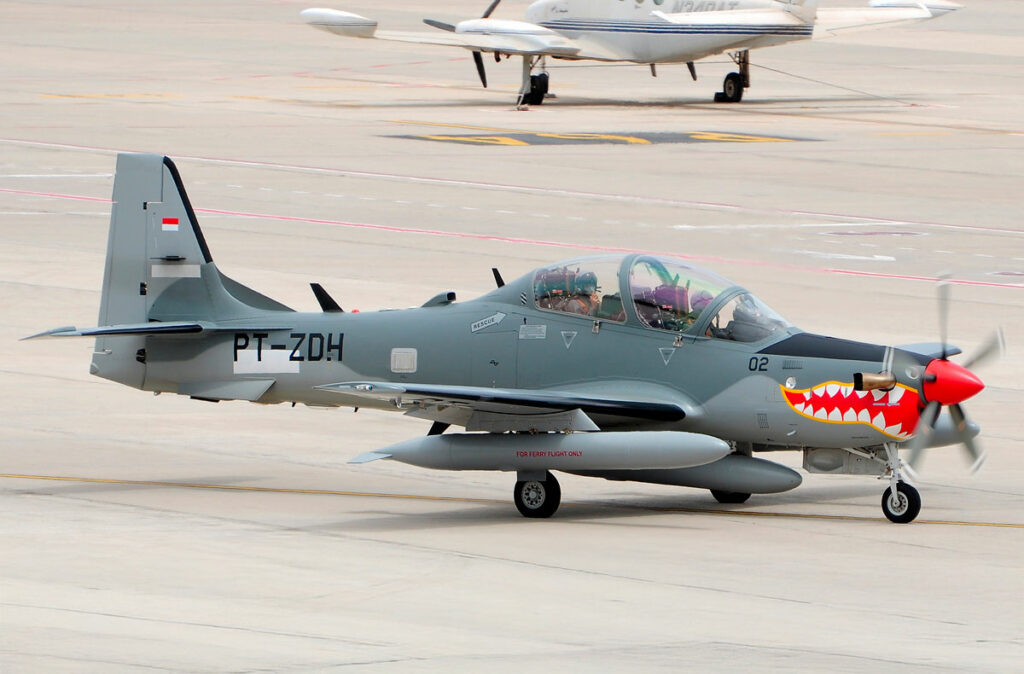
Portugal adopts the A-29N Super Tucano to empower its pilot training and reduce its dependence on the USA, with NATO capabilities.
Portugal becomes the first European country to order the Embraer A-29 Super Tucano in an A-29N version, adapted to NATO standards. This aircraft is intended to modernize the training of Portuguese pilots, which until now has depended on the DHC-1 Chipmunk, TB-30 Epsilon and the American ENJJPT program. With a range of 1330 km and an operational cost of €900/hour, the A-29 will replace the TB-30 for the advanced phase (Phase 4) and will reduce the pressure on foreign slots. It will also be used for close air support in Africa. Twelve Cirrus aircraft will replace the old Chipmunks, while Embraer sees market potential in Europe for this economical and versatile aircraft.
Modernized training with the A-29N Super Tucano
Portugal took a major step forward in December 2024 by ordering the A-29N Super Tucano, a version of the Brazilian Embraer aircraft adapted to NATO standards. This aircraft incorporates compatible data links, improved radio and navigation systems, and an IFF (Identification Friend or Foe) transponder. The objective is clear: to empower the training of Portuguese fighter pilots. Currently, students go through the DHC-1 Chipmunk (built in the 1950s, maximum speed of 222 km/h) for the bases, then the TB-30 Epsilon (speed of 520 km/h, range of 1300 km) for advanced training. From 2023, many will join the ENJJPT program in the United States, at Sheppard Air Force Base, for phases 3 and 4.
The A-29N, with a maximum speed of 590 km/h and a range of 1330 km, will take over from the TB-30. According to General Joao Rui Ramos Nogueira, the aircraft will make it possible to carry out Phase 4 (preparation for fighter planes such as the F-16) on Portuguese soil. The operational cost, estimated at €900/hour, is much lower than the €6000/hour of an F-16. In 2023, Portugal trained 15 pilots via ENJJPT, but the limited slots (around 200 annual places shared between 14 countries) prompted this transition.
Consequences
This autonomy reduces dependence on the United States, where logistical delays and high costs (an annual stay per pilot costs around €1.5 million) weigh on the budget. Locally, this strengthens the Beja airbase, which could train 20 to 25 pilots a year with a fleet of 12 A-29Ns. But the transition to all-Portuguese requires qualified instructors and appropriate maintenance, a challenge as the country starts with this aircraft. In the long term, this could inspire other NATO nations facing the same constraints.

Replacing the old DHC-1 Chipmunks with Cirrus
The DHC-1 Chipmunk, in service since the 1950s, is one of the oldest European military aircraft still operational. With a wingspan of 10.5 m and 145 hp, they train pilots in the basics of flight, but their age limits their effectiveness. In February 2025, local reports announced the purchase of 12 Cirrus aircraft (model not specified, probably SR20 or SR22) to replace them. The SR20, for example, offers a speed of 287 km/h, a range of 1570 km and modern instruments such as the glass cockpit, as opposed to the analog systems of the Chipmunk.
The cost of an SR20 is around €450,000, making the total investment in the fleet €5.4 million. These aircraft, already used by the US Air Force for initial training, will reduce maintenance costs (the Chipmunk requires rare parts, sometimes €500/unit) and improve safety, as the failure rate of old aircraft is 1 per 5000 flight hours.
Consequences
This replacement modernizes Phase 1 of the training, bringing Portugal into line with current standards. The Cirrus aircraft better prepare pilots for the technologies of the A-29N, but the transition will require instructor training, estimated at 6 months per pilot. If successful, it could free up resources for other programs, such as the maintenance of the F-16s, each overhaul of which costs €2 million. However, a mixed fleet (Cirrus and A-29N) complicates logistics in the short term.
Close support missions in Africa
In addition to training, the A-29N will be deployed for close support and counterinsurgency missions in Africa, where Portugal is participating in peacekeeping operations, particularly in Mozambique (a force of 300 soldiers in 2024). With a capacity to carry 1500 kg of weaponry (guided bombs, rockets, machine guns), the A-29 excels in asymmetrical conflicts. Its range of 1330 km allows it to cover areas such as northern Mozambique from forward bases 800 km away.
Its operating cost, €900/hour, contrasts with the €15,000/hour of a fighter such as the F-35. In 2023, Brazil used A-29s for strikes in Rondônia, neutralizing targets to within 50 m, demonstrating its accuracy. Portugal plans to have a fleet of 6 to 8 A-29Ns for these missions by 2027.
Consequences
The A-29N strengthens the Portuguese presence in Africa without increasing the budget (deployment of F-16s would cost €10 million/month). But its operational use exposes the aircraft to risks (losses estimated at 1 per 10,000 hours in hostile zones), requiring spare parts and specific training. If it is so effective, it could encourage countries such as France, which is active in the Sahel, to consider the A-29N.

Commercial potential in Europe according to Embraer
Embraer is banking on the A-29N to attract other European countries. Frederico Lemos, head of Embraer Defense and Security, emphasizes its ability to deliver live weapons in training, a rare asset for an aircraft in this category. With a unit price of €12 million, compared to €85 million for an F-16, it appeals to nations with tight budgets. In 2024, more than 260 A-29s will be in operation in 15 countries, including Brazil (99 units) and Afghanistan (20 units by 2021).
NATO has 31 members, many of which depend on foreign programs or expensive aircraft. Poland, with 48 F-16s, could consider the A-29N to reduce its costs (annual maintenance of €150 million). A fleet of 20 A-29Ns would cost €240 million, with annual maintenance of €20 million.
Consequences
If Portugal validates this model, the A-29N could compete with programs such as ENJJPT or light aircraft such as the Textron T-6 (cost of €6 million/unit). But its adoption will depend on operational tests: a Portuguese failure would slow Embraer down, while a success could generate €500 million in sales by 2030. The Baltic countries, threatened by Russia, could also see it as an economic option.
War Wings Daily is an independant magazine.